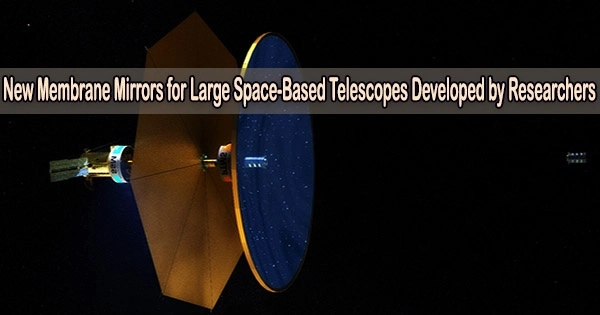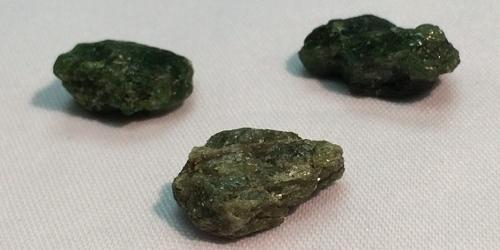Membrane mirrors are a type of deformable mirrors that use a thin, flexible membrane as the reflective surface. These mirrors are used in a variety of applications, including adaptive optics systems in astronomy, laser beam shaping, and high-power laser systems.
Researchers have invented a new method for producing and shaping big, high-quality mirrors that are substantially thinner than the primary mirrors previously used for space observatories. The resulting mirrors are tiny enough to be rolled up and placed within a launch vehicle.
“Launching and deploying space telescopes is a complicated and costly procedure,” said Sebastian Rabien from Max Planck Institute for Extraterrestrial Physics in Germany. “This new approach which is very different from typical mirror production and polishing procedures could help solve weight and packaging issues for telescope mirrors, enabling much larger, and thus more sensitive, telescopes to be placed in orbit.”
In the Optica Publishing Group journal Applied Optics, Rabien reports successful fabrication of parabolic membrane mirror prototypes up to 30 cm in diameter. These mirrors, which may be grown up to the sizes required for space telescopes, were made by growing membrane mirrors atop a rotating liquid inside a vacuum chamber using chemical vapor deposition. He also invented a technique for using heat to adaptively fix faults that may appear after the mirror is unfolded.
“Although this work only demonstrated the feasibility of the methods, it lays the groundwork for larger packable mirror systems that are less expensive,” said Rabien. “It could make lightweight mirrors that are 15 or 20 meters in diameter a reality, enabling space-based telescopes that are orders of magnitude more sensitive than ones currently deployed or being planned.”
Launching and deploying space telescopes is a complicated and costly procedure. This new approach which is very different from typical mirror production and polishing procedures could help solve weight and packaging issues for telescope mirrors, enabling much larger, and thus more sensitive, telescopes to be placed in orbit.
Sebastian Rabien
Applying an old process in a new way
The new method was developed during the COVID-19 pandemic, which Rabien says gave him some extra time to think and try out new concepts. “In a long series of tests, we researched many liquids to find out their usability for the process, investigated how the polymer growth can be carried out homogeneously, and worked to optimize the process,” he said.
A precursor material is evaporated and thermally divided into monomeric molecules for chemical vapor deposition. In a vacuum chamber, these molecules settle on the surfaces and then mix to create a polymer.
This technology is widely used to apply coatings on electronics, such as those that make them water resistant, but it is the first time it has been used to build parabolic membrane mirrors with the optical properties required for use in telescopes.
The researchers placed a revolving container loaded with a little amount of liquid to the inside of the vacuum chamber to achieve the precise shape required for a telescope mirror. The liquid creates a precise parabolic shape on which the polymer can grow and build the mirror foundation. When the polymer is thick enough, evaporation is used to apply a reflective metal layer to the top, and the liquid is washed away.
“It has long been known that rotating liquids that are aligned with the local gravitational axis will naturally form a paraboloid surface shape,” said Rabien. “Utilizing this basic physics phenomenon, we deposited a polymer onto this perfect optical surface, which formed a parabolic thin membrane that can be used as the primary mirror of a telescope once coated with a reflecting surface such as aluminum.”
Despite the fact that other organizations have developed thin membranes for similar purposes, these mirrors are normally shaped using a high-quality optical mold. Using a liquid to build the design is far less expensive and can be scaled up to larger sizes much more quickly.
Reshaping a folded mirror
This technology produces a tiny and lightweight mirror that may be readily folded or rolled up during the travel to space. However, restoring it to its original parabolic shape after unpacking would be nearly impossible.
The researchers designed a thermal approach that employs a localized temperature change caused by light to enable adaptive shape management, which can put the thin membrane into the required optical shape.
The researchers put their method to the test by fabricating 30-cm-diameter membrane mirrors in a vacuum deposition facility. They were able to build good quality mirrors with a surface shape suited for telescopes after considerable trial and error. They also proved the effectiveness of their thermal radiative adaptive shaping method using an array of radiators and illumination from a digital light projector.
The new membrane-based mirrors could also be used in adaptive optics systems. Adaptive optics can increase the performance of optical systems by compensating for incoming light distortion via a deformable mirror.
Because the surface of the new membrane mirrors is deformable, they could be shaped with electrostatic actuators to produce deformable mirrors that are less expensive to produce than conventional methods.
The researchers intend to use more advanced adaptive control in the future to investigate how well the final surface can be molded and how much initial distortion can be tolerated. They also intend to build a meter-sized deposition chamber in order to better understand the surface structure as well as the packing and unfolding procedures for a large-scale primary mirror.
















